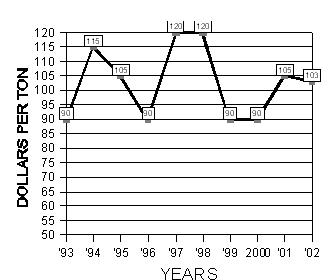Alfalfa Report
Yuma County, Arizona
December 30, 2002
Yuma County Office
2200 W. 28th Street, Ste. 102
Yuma, AZ 85364
(928) 726-3904
(928) 726-8472 FAX
Production Update:
Leaf Retention: Leaf retention in baled hay is considered desirable
and an indicator of good quality. Leaf retention is most important when
hay is feed directly since the detached leaves may be out of reach of
the animal or be combined with dirt at the bottom of the manger. Leaf
retention is not as critical where animals are feed a total mixed ration,
since detached leaves are retained in the feed by the other ingredients
in the ration.
Insect Management: Spotted alfalfa aphid (SAA) (picture)
caused severe damage to alfalfa in Arizona and California in the 1950's.
Control was achieved through a combination of introduced parasites and
host plant resistance. SAA still occasionally causes problems, but generally
only when susceptible cultivars are grown. Since 1996, SAA has occasionally
aphid appeared in damaging numbers in highly resistant alfalfa varieties.
A number of seedling alfalfa fields needed to be treated for SAA during
the fall of 2002. The reasons for the appearance of this aphid in highly
resistant cultivars is being investigated. There is every reason to believe
that the highly resistant cultivars will continue to keep the SAA in check
along with the indigenous and introduced natural enemies. SAA develops
better under warm temperatures than pea aphid or blue alfalfa aphid.
Weed Control: The rotational crop restrictions that appear on the herbicide labels are general guidelines that may differ significantly from what will occur in the field. Injury to following crops is complicated by several factors and can range from severe to none depending upon soil type, irrigation practices, climatic conditions and other cultural practices. Herbicidal effects are often variable even within the same field.
| Market Summary |
High
|
Low
|
Average
|
Off grade
|
| Past 2 Weeks (Dec. 17 - Dec. 30, 2002) |
105
|
95
|
103
|
70-90
|
| Last Year (Dec. 17- Dec. 30, 2001) |
110
|
100
|
105
|
90-100
|
10 Year Summary (Dec 17, to April 30, 1993-2002):

Issued in furtherance of Cooperative Extension work, acts of May 8 and June 30, 1914, in cooperation with the U.S. Department of Agriculture, James A. Christenson, Director Cooperative Extension, College of Agriculture and Life Sciences, The University of Arizona.
The University of Arizona is an equal opportunity, affirmative action institution. The University does not discriminate on the basis of race, color, religion, sex, national origin, age, disability, veteran status, or sexual orientation in its programs and activities.
Any products, services, or organizations that are
mentioned, shown, or indirectly implied in this web document do not imply
endorsement by The University of Arizona.
Information provided by:
Barry Tickes, btickes@ag.arizona.edu Extension Agent, Yuma County
Michael Ottman, mottman@ag.arizona.edu Agronomy Specialist
College of Agriculture, The University of Arizona.
Eric Natwick, etnatwick@ucdavis.edu UCCE Imperial County - Farm Advisor
University of California, Davis, CA.
Forages: Crop Mgmt | Soil Mgmt | Irrigation | Alfalfa Reports | Insects | Diseases | Weeds | Pesticides
Home | Other Crops | Forages
For more Arizona Production Ag Information:
Home | Cotton | Veggies| Forages | Grains | Citrus | Crop x Crop | Insects | Diseases| Weeds | Pesticides | News | Weather | Research | Photos | Contacts | General Info. | Site Map
Copyright © 2001 University of Arizona,
College of Agriculture and Life Sciences
Webmaster: Al Fournier (fournier@ag.arizona.edu)